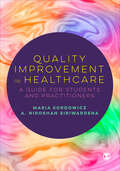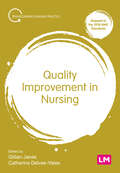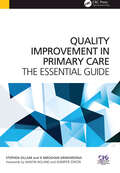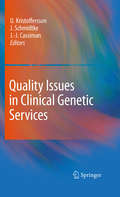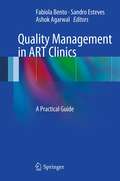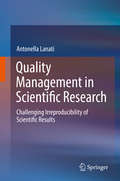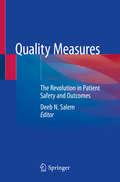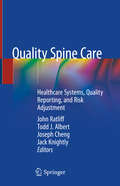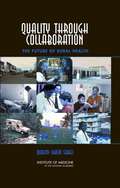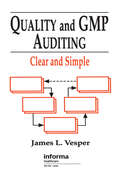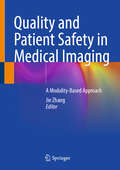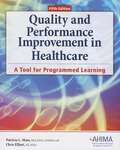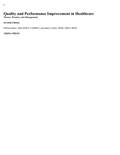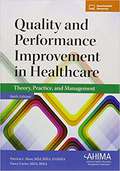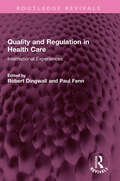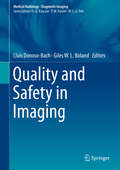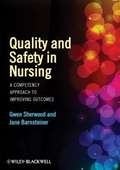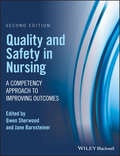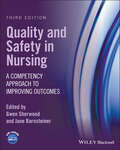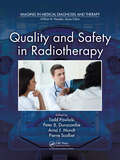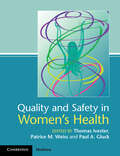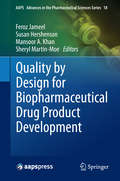- Table View
- List View
Quality Improvement in Healthcare: A Guide for Students and Practitioners
by Maria Kordowicz A. Niroshan SiriwardenaThis book introduces quality improvement for anyone studying or working in healthcare. Written in clear, straightforward language, it explores quality improvement from multiple perspectives and outlines a range models and toolkits you can use in practice. Encouraging you to reflect on your role as an improver, the book equips you with the knowledge and skills you need to work through each stage of the improvement process – from troubleshooting an issue, to working with others to make an improvement, through to its evaluation. Key features: - Case studies and activities help you to apply theory and methodology to your everyday role. - A comprehensive glossary introduces quality improvement terminology and concepts. - A logical four-part structure moves from the basics up, building your knowledge and understanding as you go.
Quality Improvement in Nursing (Transforming Nursing Practice Series)
by Catherine Delves-Yates Gillian JanesAs a student and newly registered nurse, you will need to work with others to lead, improve and sustain high quality care. This book will equip you with the skills and knowledge to do just that. From the principles and theory behind quality improvement to the practical skills and tools needed to enable it, the book develops your ability to engage in continuous quality improvement in different settings throughout your career. Key features · Mapped to the 2018 NMC Standards of Proficiency · Case studies illustrate the principles of quality improvement in real examples from practice · Walks you step by step through each aspect of a quality improvement project, from identifying a need to implementation and evaluation · Personal and professional development is discussed throughout, empowering you to engage in quality improvement from the very start of your career
Quality Improvement in Nursing (Transforming Nursing Practice Series)
by Catherine Delves-Yates Gillian JanesAs a student and newly registered nurse, you will need to work with others to lead, improve and sustain high quality care. This book will equip you with the skills and knowledge to do just that. From the principles and theory behind quality improvement to the practical skills and tools needed to enable it, the book develops your ability to engage in continuous quality improvement in different settings throughout your career. Key features · Mapped to the 2018 NMC Standards of Proficiency · Case studies illustrate the principles of quality improvement in real examples from practice · Walks you step by step through each aspect of a quality improvement project, from identifying a need to implementation and evaluation · Personal and professional development is discussed throughout, empowering you to engage in quality improvement from the very start of your career
Quality Improvement in Primary Care: The Essential Guide
by Stephen GillamThis book provides readers with an invaluable set of tools to convert the endless challenges for quality and myriad opportunities for improvement into meaningful and useful change. It considers how to manage primary care organisations in order to improve quality of care; how general practices are regulated and held accountable; various techniques used for assessing and measuring; and commonly used quality improvement frameworks.
Quality Issues in Clinical Genetic Services
by Ulf Kristoffersson J. J. Cassiman Jörg SchmidtkeInitially genetic disorders were all considered as rare diseases. At present, in the mid of 2009, the OMIM catalogue contains information on more than 12 000 entries of which about 2500 are available for clinical testing based on the identification of the responsible gene defect. However, altogether it has been estimated that about 8 percent of a population in the economically developed countries will during their lifetime suffer from a disease mainly as the result of their genetic constitution. Adding to that, it is estimated that all diseases have a genetic component, which will determine who will be at a higher than average risk for a certain disorder. Further it is postulated that in the near future, this genetic profiling could become useful in selecting an appropriate therapy adapted to the genetic constitution of the person. Thus, genetic disorders are not rare. Measuring quality of health care related processes became an issue in the 1990s, mainly in laboratory medicine, but also for hospitals and other health care systems. In many countries national authorities started to implement recommendations, guidelines or legal procedures regulating quality of health care delivery. In laboratory medicine, in parallel, the use of accreditation as a method assuring high quality standards in testing came in use. With the increasing possibilities of performing molecular genetic testing, genetic laboratories needed to become involved in this process. As many genetic disorders are rare, most laboratories worldwide offered analysis for a specific set of disorders, and, therefore, very early on a transborder flow of samples occurred. While international quality criteria (ISO) have been in existence for a number of years, the regulation of quality issues still may differ between countries. Based on their personal experience in the varying fields of quality research and clinical implementation of quality criteria in genetic services the authors of this book share their experience and give examples of the implementation of quality issues in national quality systems worldwide. This book, which is the result of the effort of many persons, is destined to aid laboratory managers and counsellors, health care managers and other stakeholders in national or international health care service to improve the services to the benefit of patients with suspected genetic disorders.
Quality Management and Accreditation in Hematopoietic Stem Cell Transplantation and Cellular Therapy: The JACIE Guide
by Patrick Hayden Mahmoud Aljurf John A. Snowden Kim H. Orchard Eoin McGrathThis open access book provides a concise yet comprehensive overview on how to build a quality management program for hematopoietic stem cell transplantation (HSCT) and cellular therapy. The text reviews all the essential steps and elements necessary for establishing a quality management program and achieving accreditation in HSCT and cellular therapy. Specific areas of focus include document development and implementation, audits and validation, performance measurement, writing a quality management plan, the accreditation process, data management, and maintaining a quality management program. Written by experts in the field, Quality Management and Accreditation in Hematopoietic Stem Cell Transplantation and Cellular Therapy: A Practical Guide is a valuable resource for physicians, healthcare professionals, and laboratory staff involved in the creation and maintenance of a state-of-the-art HSCT and cellular therapy program.
Quality Management in ART Clinics
by Ashok Agarwal Fabiola Bento Sandro EstevesIn the last decades, major advances have been made in assisted reproductive technologies (ART) and the public demand for these procedures has increased globally. All ART clinics, from those just starting out to the well established, must employ the latest equipment and implement the best practices, while ensuring that their resources are effectively engaged to optimize patient outcomes. This is a tenet of the fiduciary role of physicians and it is increasingly recognized as a quantifiable goal regulated by formal certifications and accreditations. Quality management protocols such as those proposed by the International Organization for Standardization (ISO) are being rapidly adopted as standards of measure. Quality Management in ART Clinics: A Practical Guide provides easily adoptable ways to implement and improve formalized quality management systems. Essential to any clinic to achieve best practices and maintenance of formal regulatory certifications, this book brings together the know-how of experienced opinion leaders operating in key areas worldwide. The book offers an overview of primary regulations in the ART field, with attention to quality management demands, and links specific requirements to practical steps for implementation. Filled with process and procedure examples, flow diagrams and administrative form templates, this book is the first of its kind, gathering the necessary elements for optimizing practice, management, and quality assurance.
Quality Management in Intensive Care
by Guidet, Bertrand and Valentin, Andreas and Flaatten, Hans Bertrand Guidet Andreas Valentin Hans FlaattenThis book is one of the first to comprehensively summarise the latest thinking and research in the rapidly evolving field of quality management in intensive care. Quality indicators and outcome measures are discussed with a practical focus on patient-centred, evidence-based implementation for safer and more effective clinical practice. Chapters on topics such as teambuilding, patient satisfaction, mortality and morbidity, and electronic management systems are organised into three sections, covering quality management at the scale of the individual patient, the intensive care unit, and the national and international level. Written by a team of over forty international experts in the specialty, with editors who have been heavily involved for many years with the European Society of Intensive Care Medicine, the book reflects commonly accepted goals and guidelines for best practice, and will be valuable for practitioners worldwide. The ideal one-stop resource for intensive care physicians as well as ICU and hospital managers.
Quality Management in Scientific Research: Challenging Irreproducibility Of Scientific Results
by Antonella LanatiIn recent years, the attention of the scientific and social community has not solely been on producing new findings, but increasingly also on the related issues of the reliability, safety, and efficacy of the discoveries made, as well as the efficient and effective use of resources. The adoption of management models and tools can help scientists to improve their research, ensuring valuable, robust and dependable outcomes. Quality disciplines have been widely used for decades in industrial and business fields, building a knowledge base that can be translated and exploited, much to the advantage of scientific research. However, quality references in scientific research are still extremely rare and largely limited to an international guideline and a few sector-specific standards. Despite WHO and EU Commission campaigns, there are still precious few practical texts that offer researchers guidance on quality principles and provide simple tools and methodologies for their daily work. The book, starting from the problem of the reproducibility of scientific results and the substantial contribution that the Quality approach can make to research (Chapter 1), introduces the reader to key principles and basic concepts of Quality and illustrates both general and research-specific quality standards, paving the way for further discussion (Chapter 2). In turn, Chapter 3 presents detailed applications of Quality principles in various aspects of research, from study and ethics to materials and equipment management. Chapters 4 and 5, respectively, are devoted to Quality tools and Quality methodologies, as well as soft skills, all of which are valuable to scientific experimentation and study management. The concepts and practical tools discussed are extensively illustrated with examples from actual applications in scientific research.
Quality Measures: The Revolution in Patient Safety and Outcomes
by Deeb N. SalemWhile the healthcare system continues to shift towards more emphasis on quality metrics, there remains a substantial gap between the expectations of healthcare policies and standards of hospital administrations vs. the realistic care provided by the average healthcare provider. This book offers the perspective of the healthcare provider and aims to fulfill the unmet need to educate other healthcare providers on recognizing quality measures and understanding how to achieve them to meet standards of quality care. This book covers the historical perspective of quality measures, the context of their existence, their utility, and the contemporary issues related to their use. Simultaneously, it critically addresses the quality of these quality metrics and presents the evidence available to date on the efficacy and the limitations of these quality measures. This text is all-inclusive and is organized into chapters that include the evolution of quality metrics in healthcare, the practical role of hospitals, as well as the practical role of individual healthcare providers in addressing quality metrics. The chapters also include assessment of quality metrics that uniquely pertain to medical and surgical practices, as well as non-clinical quality metrics that specifically target undergraduate and graduate medical training. Finally, the book reflects on the use of contemporary quality metrics and their impact on outcomes, patient care, and public health and policy making. In these chapters, tables and illustrations, including algorithms, will be used to provide systematic approaches to common issues related to quality metrics. In addition, historical anecdotes and case presentations will be used to address pearls in contemporary practice of quality metrics. Quality Measures is the definitive reference on quality metrics in healthcare and is a valuable resource for healthcare providers, trainees, administrators and public health agencies.
Quality Spine Care: Healthcare Systems, Quality Reporting, And Risk Adjustment
by John Ratliff Todd J. Albert Joseph Cheng Jack KnightlyQuality reporting is a rapidly growing area. Each year, new regulations in the US from the Council of Medicare and Medicaid Services make quality reporting a larger factor in determining reimbursement practices. Quality metrics are common parts of European clinical practice. Value of care is a focus of all payers, with specific interest directed at assessing the quality of care provided by a given healthcare team. While there are many publications in this space, no text has sought to provide an overview of quality in spine care. Quality measurement and quality reporting are ever growing aspects of the healthcare environment. Quality assessment is valuable to all healthcare stakeholders: patients, physicians, facilities, and payers. Patients are drawn to facilities that provide high value care; public reporting systems and grading systems for hospitals offer one opinion with regard to “high quality care.” Most physicians email inboxes are inundated with offers of recognition for being a “Top Doc” for a nominal fee. Some payers offer incentives to patients who chose to be treated at “Centers of Excellence” or similar facilities; the definition of “Excellence” may be unclear. There is little consensus on how to measure quality, how to incorporate patient and procedure factors and achieve accurate risk adjustment, and how to define value of care. Regardless of these challenges, regulatory efforts in the US, as well as numerous international efforts, make quality assessment and quality reporting an important part of physician behaviour. Physician and facility reimbursement for procedures are often tied to quality metrics. Spine procedures are costly, elective, and are a focus of many payer-based programs. Hence, spine care is often a focus of quality reporting efforts. This text summarizes the state of the art with regard to quality measurement, reporting, and value assessment in spine care. We will review quality reporting in the US and internationally. Chapters will outline how quality improvement efforts have achieved success in hospital systems. The reader will be provided with insights in how to achieve success incorporating quality metrics into spine care.Features:1. Illustrates the state of the art in spine quality reporting: There is no text that thoroughly addresses quality assessment and quality reporting in spine care; there are, however, numerous articles in this space. This book provides a definitive text covering the state of the art for quality reporting in spine care and will be of value to the international orthopedic and neurosurgical spine community.2. Provides insight on quality reporting in different healthcare systems: The text will allow for comparison of different quality reporting systems from different health care systems. This will provide practitioners with insight into the strengths and weaknesses of different approaches to quality reporting, and may drive improvement in quality assessment and reporting systems. A single text that features review of US, European, and Australia/Asian health care systems’ quality reporting is novel and will be thought provoking for readers. 3. Describes the US and international Healthcare reimbursement systems: Practicing physicians are provided with little information and less insight into the vagaries of the US and other healthcare systems. The text will provide insight into code development, valuation, and how quality reporting affects physician reimbursement4. Explains risk adjustment: Appropriate risk adjustment and assessing patient and procedure factors that may impact quality reporting are invaluable to accurate quality measurement. The text will review risk adjustment, different approaches to risk assessment/mitigation, and provide physicians with insights into appropriate measures to capture in their clinical practices5. Provides a foundation for improved quality assessment in spine care: While there are many disparate elements and differing approaches to capturing spine quality metrics, no definitive text has attempted to s
Quality Through Collaboration: The Future Of Rural Health
by Institute of Medicine of the National AcademiesBuilding on the innovative Institute of Medicine reports To Err Is Human and Crossing the Quality Chasm, Quality Through Collaboration: The Future of Rural Health offers a strategy to address the quality challenges in rural communities. Rural America is a vital, diverse component of the American community, representing nearly 20 % of the population of the United States. Rural communities are heterogeneous and differ in population density, remoteness from urban areas, and the cultural norms of the regions of which they are a part. As a result, rural communities range in their demographics and environmental, economic, and social characteristics. These differences influence the magnitude and types of health problems these communities face. Quality Through Collaboration: The Future of Rural Health assesses the quality of health care in rural areas and provides a framework for core set of services and essential infrastructure to deliver those services to rural communities. The book recommends: Adopting an integrated approach to addressing both personal and population health needs Establishing a stronger health care quality improvement support structure to assist rural health systems and professionals Enhancing the human resource capacity of health care professionals in rural communities and expanding the preparedness of rural residents to actively engage in improving their health and health care Assuring that rural health care systems are financially stable Investing in an information and communications technology infrastructure It is critical that existing and new resources be deployed strategically, recognizing the need to improve both the quality of individual-level care and the health of rural communities and populations.
Quality and GMP Auditing: Clear and Simple
by James L. VesperThis guidebook provides proven methods and techniques for performing effective audits that serve your department, your company, and you. Topics covered relate to the four key competencies essential for successful GMP audits. Includes the rationale for auditing as an important quality tool, along with the audit cycle, broken into five distinct phase
Quality and Patient Safety in Medical Imaging: A Modality-Based Approach
by Jie ZhangThis book serves as a comprehensive resource for both the public and professionals in the medical imaging field. Its primary objective is to address the critical concerns related to quality and patient safety within the context of various imaging techniques. The field of medical imaging is constantly evolving, with advancements in technology and techniques, making it crucial to stay updated with the latest information. This book aims to bridge the knowledge gap in this domain by providing an in-depth understanding of the indications, performance, and safety aspects of various imaging modalities. Chapters offer insights into the indications and performance of key imaging techniques, including X-ray, magnetic resonance imaging (MRI), computed tomography (CT), ultrasound, women's imaging, DEXA (Dual-Energy X-ray Absorptiometry), dental imaging, and nuclear medicine.They additionally provide an up-to-date overview of quality assurance and quality control programs relevant to medical imaging and explore the safety concerns associated with imaging techniques, including radiation exposure, the use of contrast agents, and image-guided biopsy. This book addresses a significant gap in the field of medical imaging by providing a comprehensive and up-to-date resource that is accessible. It combines technical and clinical information with a focus on quality and safety, making it an essential reference for individuals seeking to understand and navigate the complexities of medical imaging. The book's structured approach, incorporating the latest regulations and ongoing quality improvement efforts, ensures that readers are equipped with the knowledge necessary to provide and receive safe and effective medical imaging services.
Quality and Performance Improvement in Healthcare: A Tool for Programmed Learning
by Chris Elliott Patricia L. ShawThis is the fifth edition of the best-selling Quality and Performance Improvement in Healthcare: A tool for Programmed Learning. Covering trends in healthcare quality control and performance, it also serves as a solid source on Performance Improvement (PI) foundations, fundamentals, and core principles.
Quality and Performance Improvement in Healthcare: Theory, Practice, and Management
by Patricia L. ShawYou will soon be entering your chosen profession in the healthcare field. The issues involved in the management of quality in healthcare span the various clinical and administrative disciplines and must be approached from a variety of perspectives. Many improvements for healthcare services are developed through team-based activities. Employers also will expect you to be able to apply performance improvement (PI) data analysis and presentation tools. Prepare now for the possibility that at some point in the future you will be asked to facilitate a PI team meeting.
Quality and Performance Improvement in Healthcare: Theory, Practice, and Management, Sixth Edition
by Darcy Carter Patricia L. Shaw MEd Rhia Fahima MhaThis text book from AHIMA presents a comprehensive introduction to the theory, practice, and management of performance and quality improvement processes in healthcare organizations.
Quality and Regulation in Health Care: International Experiences (Routledge Revivals)
by Robert Dingwall Paul FennFirst published in 1992, Quality and Regulation in Health Care employs socio-legal ideas concerning regulation to examine the methods used to influence the quality of health care in the US, UK, and Western Europe. Throughout the Western world, health care systems, both public and private, are grappling with the problems of assuring quality while containing costs. On the one hand, governments and insurers argue that there must be some limit to the apparently endless growth of health care expenditures. On the other, patient groups and consumer advocates, already dissatisfied by the problems in holding doctors accountable for their actions, protest that such limits must not result in sick people getting inferior treatment. This book examines in detail the debate surrounding the question: How can the professional expertise of the clinicians be reconciled with the preferences of their patients and the economic concerns of taxpayers or insurers? It will be essential reading for graduate and undergraduate courses in health policy, medical sociology, and health law.
Quality and Safety in Imaging (Medical Radiology)
by Lluís Donoso-Bach Giles W. L. BolandThis book provides a roadmap for optimizing quality and safety within radiology practices, whether academic or private and irrespective of their national setting. All aspects of the radiology workflow are addressed, from imaging appropriateness, examination scheduling, and patient preparation through to imaging protocol optimization (including radiation dose management), modality operations, reporting (including structured reporting), and report communication. The book highlights innovative IT tools, including clinical decision support, that drive compliance with national best practice standards and guidelines. The use of big data tools to manage and enhance clinical delivery is addressed. Finally, metrics designed to measure the value that radiology brings to patient care and patient outcomes are introduced. Readers wishing to deepen their understanding of contemporary best practices regarding quality and safety will find this book to be a rich source of practical information.
Quality and Safety in Nursing
by Rn Phd Gwen Sherwood Faan Jane BarnsteinerQuality and Safety in Nursing: A Competency Approach to Improving Outcomes is the first comprehensive text of its kind devoted to the nursing community's role in improving quality of care and patient safety. Edited by key members of the Quality and Safety Education for Nursing (QSEN) steering team, the book brings together information from various loci and expertly situates it within the continuum of nursing education and practice. Quality and Safety in Nursing is divided into three sections. The first section links the national initiative for quality and safety to its origins in the IOM report. Section Two defines each of the six QSEN competencies in turn, provides instruction on acquiring the skills needed to achieve each competency, and constructs a framework for implementation. Section Three further defines implementation strategies in formal education as well as transition into practice. A key resource for academics and clinicians alike, Quality and Safety in Nursing is an essential addition to the library of nurse leaders across the globe.
Quality and Safety in Nursing: A Competency Approach to Improving Outcomes
by Gwen Sherwood Jane BarnsteinerDrawing on the universal values in health care, the second edition of Quality and Safety in Nursing continues to devote itself to the nursing community and explores their role in improving quality of care and patient safety. Edited by key members of the Quality and Safety Education for Nursing (QSEN) steering team, Quality and Safety in Nursing is divided into three sections. Itfirst looks at the national initiative for quality and safety and links it to its origins in the IOM report. The second section defines each of the six QSEN competencies as well as providing teaching and clinical application strategies, resources and current references. The final section now features redesigned chapters on implementing quality and safety across settings. New to this edition includes: Instructional and practice approaches including narrative pedagogy and integrating the competencies in simulation A new chapter exploring the application of clinical learning and the critical nature of inter-professional teamwork A revised chapter on the mirror of education and practice to better understand teaching approaches This ground-breaking unique text addresses the challenges of preparing future nurses with the knowledge, skills, and attitudes (KSAs) necessary to continuously improve the health care system in which they practice.
Quality and Safety in Nursing: A Competency Approach to Improving Outcomes
by Gwen Sherwood Jane BarnsteinerQuality and Safety in Nursing First published in 2012, Quality and Safety in Nursing was the first volume of its kind to explore the role of the nursing community in improving quality of care and patient safety. Now in its third edition, this comprehensive resource remains essential reading for all those involved in equipping current and future nurses with the knowledge, skills, and attitudes (KSAs) needed to deliver exceptional care. The new edition begins with an overview of the Quality and Safety Education for Nurses (QSEN) initiative and its origins in the Future of Nursing report published in 2010, before defining each of the six QSEN competencies: patient-centered care, teamwork and collaboration, evidence based practice, quality improvement, safety and informatics. The content incorporates the 2020-2030 Future of Nursing recommendations, as well as the 2021 AACN Essentials for Education competencies. Finally, the text presents both teaching and clinical application strategies for building and implementing a culture of quality and safety across settings. Integrates QSEN competencies in simulation and provides new instructional and practice approaches Features redesigned chapters for reimagining classroom and clinical learning, applying reflective practices and transforming education and practice through inter-professional teamwork Provides new case studies and personal accounts highlighting key principles and their application in real-world scenarios Contains new and expanded material on assessment and evaluation, transition to practice, leadership and management, and primary, outpatient, and ambulatory care Offers a new discussion of future research directions and global perspectives on quality and safety Quality and Safety in Nursing, Third Edition is required reading for graduate students in nursing education programs, faculty in nursing schools, nursing and healthcare educators, clinical nurse specialists, clinical administrators, and those working in professional development and quality improvement.
Quality and Safety in Radiotherapy (Imaging in Medical Diagnosis and Therapy)
by Todd Pawlicki Pierre Scalliet Peter B. Dunscombe Arno J. MundtThe first text to focus solely on quality and safety in radiotherapy, this work encompasses not only traditional, more technically oriented, quality assurance activities, but also general approaches of quality and safety. It includes contributions from experts both inside and outside the field to present a global view. The task of assuring quality
Quality and Safety in Women’s Health
by Thomas IvestarDesigned for all providers of women's healthcare - including those undertaking Maintenance of Certification programs, trainees preparing for postgraduate examinations, and those initiating or growing a program of quality improvement and patient safety - this practical manual guides those implementing QI and safety programs with specific emphasis on Obstetrics and Gynecology practice. <P><P><P>The content contains a strong case-based element to improve accessibility and understanding. An introductory section covers core attributes needed by all physicians to build a culture of patient safety, including leadership, communication and QI skills. Core clinical skills are then reviewed - in a variety of labor ward, office, operating room, and outpatient settings. Finally systems implications are highlighted, including information transparency and disclosure, training programs, and regulatory and legal implications. The editors are involved with national and international initiatives educating physicians in safety aspects of practice. <P>The book is published in collaboration with the Foundation for EXXcellence.<P> Covers a mandatory element of US obstetrics and gynecology training,<P> Discusses core skills and attributes which are important for all physicians.<P> Case studies throughout make the text accessible and easy to learn from.
Quality by Design for Biopharmaceutical Drug Product Development
by Feroz Jameel Susan Hershenson Mansoor A. Khan Sheryl Martin-MoeThis volume explores the application of Quality by Design (QbD) to biopharmaceutical drug product development. Twenty-eight comprehensive chapters cover dosage forms, liquid and lyophilized drug products. The introductory chapters of this book define key elements of QbD and examine how these elements are integrated into drug product development. These chapters also discuss lessons learned from the FDA Office of Biotechnology Products pilot program. Following chapters demonstrate how QbD is used for formulation development ranging from screening of formulations to developability assessment to development of lyophilized and liquid formats. The next few chapters study the use of small-scale and surrogate models as well as QbD application to drug product processes such as drug substance freezing and thawing, mixing, sterile filtration, filling, lyophilization, inspection and shipping and handling. Later chapters describe more specialized applications of QbD in the drug product realm. This includes the use of QbD in primary containers, devices and combination product development. The volume also explores QbD applied to vaccine development, automation, mathematical modeling and monitoring, and controlling processes and defining control strategies. It concludes with a discussion on the application of QbD to drug product technology transfer as well as overall regulatory considerations and lifecycle management. Quality by Design for Biopharmaceutical Drug Product Development is an authoritative resource for scientists and researchers interested in expanding their knowledge on QbD principles and uses in creating better drugs.
